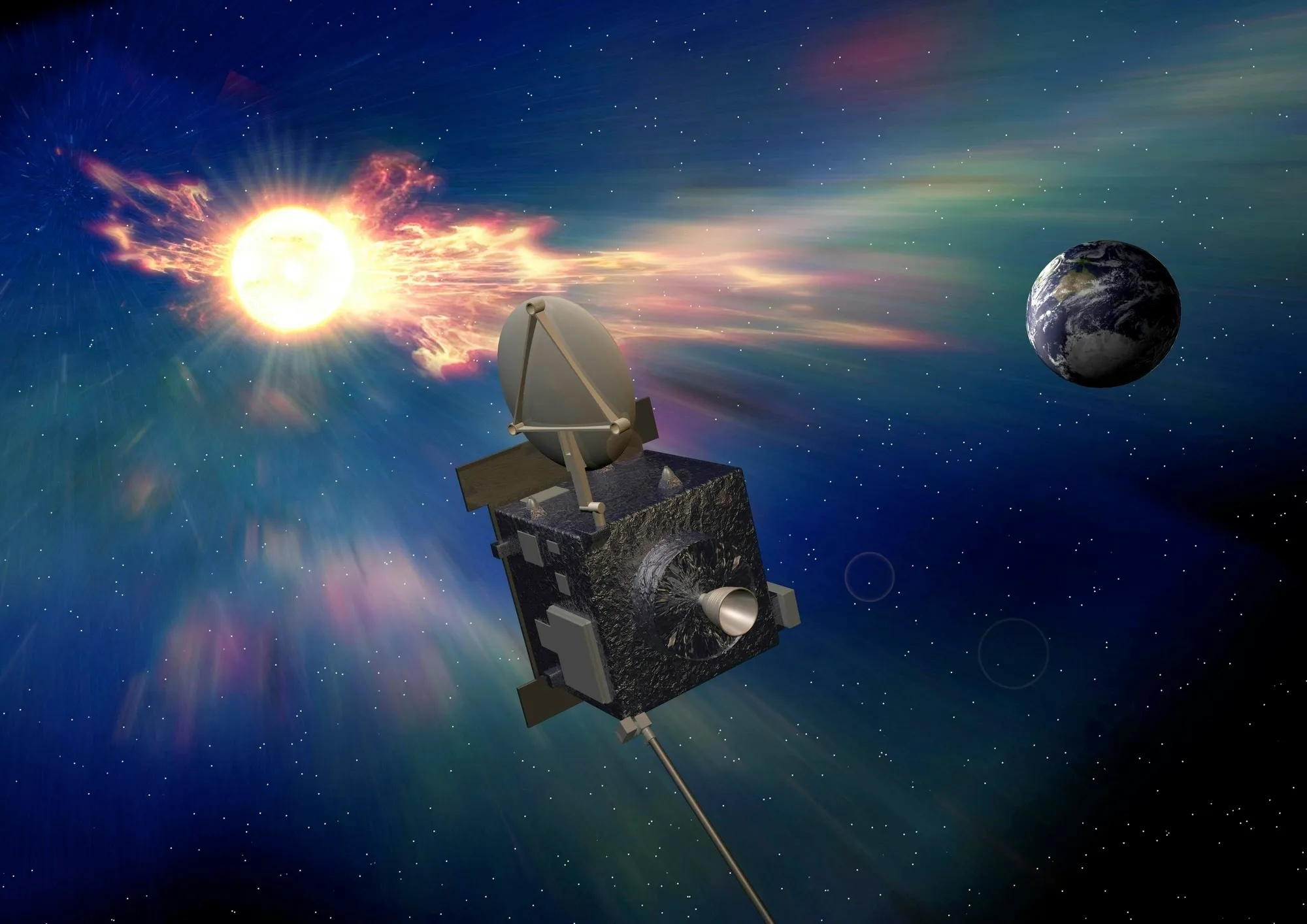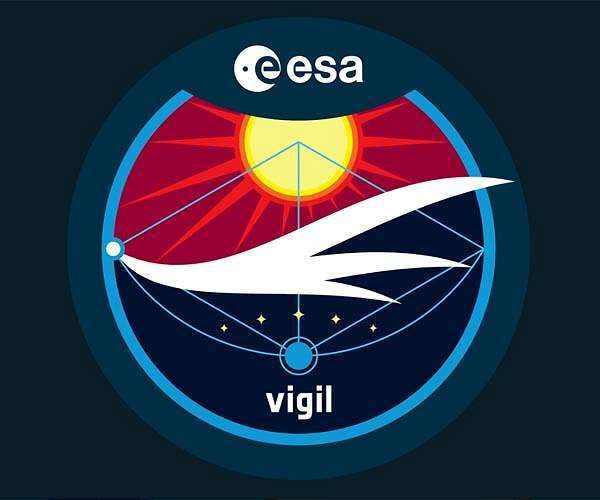25.05.2024

ESA’s Vigil spacecraft will watch the sun from the L-5 Lagrange point. Credit: Airbus
WASHINGTON — The European Space Agency has awarded Airbus Defence and Space a contract to build a spacecraft that will provide a unique view of the sun.
ESA held a signing ceremony May 22 in Brussels for a contract valued at 340 million euros ($369 million) for the Vigil spacecraft. Airbus will build Vigil at its facilities at Stevenage in the United Kingdom.
Slated to launch in 2031, Vigil will operate at the Earth-sun L-5 Lagrange point, trailing the Earth by 60 degrees in its orbit. It will complement spacecraft at the L-1 point, between the Earth and the sun, by viewing regions of the sun before they rotate into view of the Earth, thus providing advance warning of solar activity.
“Data from Vigil can give us an unprecedented notice of up to four to five days for certain space weather effects traveling to Earth,” said Giuseppe Mandorlo, ESA project manager for Vigil, in a statement. “From its vantage point from the ‘side’, Vigil can also observe much more clearly the speed, direction and chance of impact of coronal mass ejections.”
“Vigil will be Europe’s first 24/7 operational space weather satellite, providing valuable time to protect critical infrastructure such as power grids or mobile communication networks on Earth as well as valuable satellites in Earth orbit,” said ESA Director General Josef Aschbacher in a statement. “Vigil will drastically improve both the lead time of space weather warnings as well as their level of detail from its unique vantage point in deep space.”
British officials said development of Vigil will support more than 150 jobs in the country. “The development of the Vigil space weather mission, right here on British soil in Stevenage, is a testament to our central role within the European Space Agency and our world-class expertise in space manufacturing,” said Andrew Griffith, minister for space in the British government, said.
Vigil will carry six instruments, four of which from European institutes. The National Ocean and Atmospheric Administration in the United States is providing another instrument, a compact coronagraph based on designs developed at the Naval Research Lab flying on the GOES-U weather satellite launching in June and the Space Weather Follow On L-1 mission in 2025.
NASA announced May 20 it will develop the Joint EUV coronal Diagnostic Investigation, or JEDI, instrument that will also go on Vigil. JEDI will provide extreme ultraviolet observations of the sun. The Southwest Research Institute will lead development of JEDI under a $45 million NASA contract.
Quelle: SN
+++
Airbus awarded 340 million euro ESA contract for Vigil satellite

ESA has signed a euro 340 million contract with Airbus Defence and Space UK to develop the Vigil satellite. This satellite will improve early warning systems for severe space weather events, such as solar storms, from its unique position in deep space.
A declaration celebrating the contract was signed by ESA, Airbus Defence and Space, and the UK Minister of State for Science, Research and Innovation at the Royal Museum of Fine Arts in Brussels.
"Vigil will be Europe's first 24/7 operational space weather satellite, providing valuable time to protect critical infrastructure such as power grids or mobile communication networks on Earth as well as valuable satellites in Earth orbit, including the International Space Station ISS," said ESA Director General Josef Aschbacher. "Vigil will drastically improve both the lead time of space weather warnings as well as their level of detail from its unique vantage point in deep space."
Patrick Wood, Head of Space Systems UK at Airbus Defence and Space, stated, "Vigil is one of the most exciting and important space missions that will not only improve our understanding of the Sun's behaviour but crucially provide us with earlier warning and greater precision about potentially damaging solar weather. Space weather forecasters will be able to see what is coming from the Sun and provide more accurate alerts."
Andrew Griffith MP, Minister for Space at the Department for Science, Innovation and Technology, added, "Space weather generates stunning phenomena like the recent displays of the 'Northern lights' over our skies - but it also presents a real risk to our way of life which is increasingly dependent on space and satellite services. The Vigil mission will transform our understanding of the impact of potentially dangerous solar events and I congratulate Airbus here in the UK on taking the lead in this important mission."
Vigil will provide near real-time data on hazardous solar activity before it is detectable from Earth. This data will enable operators of satellites, power grids, and telecommunication systems to take protective measures and give human space explorers time to get to safety.
"Without warning, space weather storms can cause potentially serious health problems for astronauts and the economic impact of space weather can be extensive, especially as we come to rely more and more on critical technologies underlying navigation, banking, aviation, power grids and telecommunications," said Holger Krag, Head of the Space Safety Programme at ESA. "Depending on the severity of an event, damage estimates range from multiple billions up to three trillion euro in case of an event of comparable magnitude as the biggest one we know, the 1859 Carrington Event."
Vigil will monitor the Sun from the Lagrange point L5 in deep space. This position allows it to observe solar activity days before it is visible from Earth.
"Vigil will continuously feed data into operational space weather services and further solar science at the same time. Vigil is also equipped with scientific instruments that will bring its own space weather services to a new level as they fuel further improvement of its forecasting abilities," explained Giuseppe Mandorlo, Vigil Project Manager at ESA. "Data from Vigil can give us an unprecedented notice of up to four to five days for certain space weather effects traveling to Earth. And from its vantage point from the 'side', Vigil can also observe much more clearly the speed, direction and chance of impact of coronal mass ejections (CMEs)."
The data collected by Vigil will be integrated into the ESA Space Weather Service Network, which is part of the agency's Space Safety Programme.
"The need and appetite for space weather services is growing as the potential impact of space weather events becomes more critical with our increased dependence on satellites in space," said Alexi Glover, Space Weather Service Coordinator at ESA. "The data from Vigil at L5 will be combined with available data from the Sun-Earth line, resulting in more detailed and precise forecasts for our end users across many industries. This enables them to respond as early as possible to protect Earth's infrastructure, satellites, inhabitants and astronauts."
Airbus Defence and Space will build the satellite, including design, development, integration, testing, launch, and in-space commissioning. The spacecraft will be assembled at Airbus Defence and Space Ltd. in Stevenage, UK. The payload suite includes imaging and in situ sensing instruments from European institutes and industrial partners, as well as two instruments from NASA and NOAA.
The Vigil payload will include:
- Photospheric Magnetographic Imager (Germany), Max Planck Institute for Solar System Research (MPS)
- Heliospheric Imager (Italy, Belgium), Leonardo SpA/CSL, Belgium
- Compact Coronagraph (USA, NOAA), Naval Research Lab
- Plasma Analyser (UK), Mullard Space Science Lab
- Magnetometer (UK/Austria), Imperial College London/IWF Graz
- Extreme ultraviolet (EUV) Imager 'JEDI' (USA, NASA), prime contractor under final selectionB
Vigil is planned for launch in 2031.
Quelle: SD
